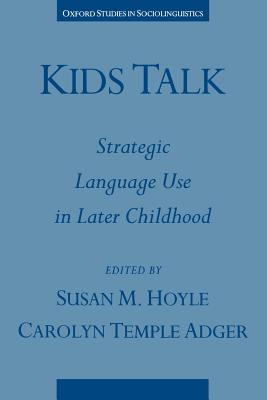Between early childhood and adulthood, language acquisition is succeeded by a bloom of repertoire for managing interaction, a growing sensitivity to the relation of language and society, an expanding ability to wield power through the strategic use of language, and an increasing sophistication in framing speech activities. This book examines a wide range of language practices among school-age children and teenagers, using data from naturally occurring recorded talk and from careful observation of interaction in peer groups. The contributors analyze talk at play, at school, and at work, documenting the growing communicative skills of young people while always focusing on what young speakers themselves do with (and through) language. Theoretical constructs to which the contributors appeal include Goffman's notion of footing and Hymes' communicative competence, as well as multiple characterizations of discourse structure. The chapters show older children as strategic language users, dynamic actors who are often concerned with defining themselves as a distinctive group, different from adults, yet who just as often display proficiency at sophisticated discourse activities that presage those of adulthood.
| FindBook |
有 1 項符合
Kids Talk: Strategic Language Use in Later Childhood的圖書 |
 |
Kids Talk: Strategic Language Use in Later Childhood 作者:Hoyle、Susan M.(EDT)/Adger、Carolyn Temple(EDT 出版社:Oxford University Press, USA 出版日期:1998-09-10 語言:英文 規格:平裝 / 312頁 / 22.6 x 15.5 x 2 cm / 普通級 |
| 圖書館借閱 |
| 國家圖書館 | 全國圖書書目資訊網 | 國立公共資訊圖書館 | 電子書服務平台 | MetaCat 跨館整合查詢 |
| 臺北市立圖書館 | 新北市立圖書館 | 基隆市公共圖書館 | 桃園市立圖書館 | 新竹縣公共圖書館 |
| 苗栗縣立圖書館 | 臺中市立圖書館 | 彰化縣公共圖書館 | 南投縣文化局 | 雲林縣公共圖書館 |
| 嘉義縣圖書館 | 臺南市立圖書館 | 高雄市立圖書館 | 屏東縣公共圖書館 | 宜蘭縣公共圖書館 |
| 花蓮縣文化局 | 臺東縣文化處 |
|
|
圖書介紹 - 資料來源:博客來 評分:
圖書名稱:Kids Talk: Strategic Language Use in Later Childhood
內容簡介
|




![塔木德:猶太人的致富聖經[修訂版]:1000多年來帶領猶太人快速累積財富的神祕經典 塔木德:猶太人的致富聖經[修訂版]:1000多年來帶領猶太人快速累積財富的神祕經典](https://media.taaze.tw/showLargeImage.html?sc=11100697818)




